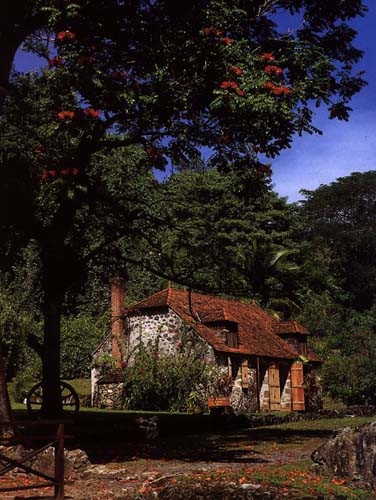In 1763, in a truly beautiful spot overlooking the Caribbean Sea, was born a child with a most extraordinary future ahead of her: for this little girl was none other than Marie-Joseph-Rose Tascher de la Pagerie, who was to become Josephine, Empress of the French.
Josephine spent the first sixteen years of her life in the Domaine de la Pagerie, known at that time as “Petite Guinée” – it covered more than 300 hectares was worked by 200 slaves. The estate's main income derived from the cultivation and making of sugar, coffee and indigo, which were exported to France. The building in which Josephine was born was destroyed by a hurricane in 1766. However, the walls of Madame de la Pagerie's room were rebuilt and today constitute a charming little stone house with pink tiles, with a small museum devoted to the Empress contining 200 items. Here visitors can admire the bed made of Courbaril wood that Josephine slept in as a young girl, Napoleon's letters to her, as well as furniture and objects that belonged to her.
Not much is left of the sugar factory where Josephine's family took refuge during the hurricane and where it settled after the catastrophe. The sugar mill of the factory, where the canes were melted down, is today the visitor's centre. All of these buildings are surrounded by a beautiful garden where Josephine's bust is displayed amid banks of flowers.
Josephine is also remembered in the little church of the Trois-Ilets, where her parents were married and where Josephine herself was baptized on July 27, 1763. A commemorative plaque on the front of the church recalls the event alongside another plaque placed there in 1921 during the celebrations of the centenary of Napoleon's death. In the left transept lies the tomb of Rose-Claire Vergers de Sanois, Josephine's mother.
During the Second Empire, a statue of the Empress by Vital-Dubray was erected in Savane Square, in the centre of Fort-de-France. On the pedestal there is a bas-relief depicting the coronation followed by the inscription: “IN MDCCCLVIII, DURING THE REIGN OF NAPOLEON III, THIS MONUMENT WAS ERECTED BY THE INHABITANTS OF MARTINIQUE”. This statue is today minus its head and bears witness to the change heart towards the empress on the part of the locals from Martinique.
Domaine de la Pagerie


